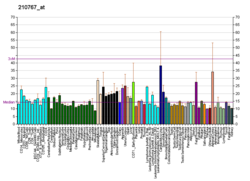Function
Merlin is a membrane-cytoskeleton scaffolding protein, i.e. linking actin filaments to cell membrane or membrane glycoproteins. [10] Human merlin is predominantly found in nervous tissue, but also in several other fetal tissues, and is mainly located in adherens junctions. [11] Its tumor suppressor properties are probably associated with contact-mediated growth inhibition. Drosophila merlin is expressed in embryonic hindgut, salivary glands, and imaginal discs, and has apparently a slightly different role than in vertebrates. [12]
The phosphorylation of serine 518 is known to alter the functional state of merlin. [13] The signaling pathway of merlin is proposed to include several salient cell growth controlling molecules, including eIF3c, CD44, protein kinase A, and p21 activated kinases.
Work in Drosophila identified Merlin as an upstream regulator of the Hippo tumor suppressor pathway, [14] a function that is conserved in mammals. [15] The Hippo pathway is a well conserved signalling pathway that coordinately regulates cell proliferation and apoptosis. [16]
Mutations of the NF2 gene cause a human autosomal dominant disease called neurofibromatosis type 2. It is characterized by the development of tumors of the nervous system, most commonly of bilateral vestibular schwannomas (also called acoustic neuromas). NF2 belongs to the tumor suppressor group of genes. [17]
This page is based on this
Wikipedia article Text is available under the
CC BY-SA 4.0 license; additional terms may apply.
Images, videos and audio are available under their respective licenses.









